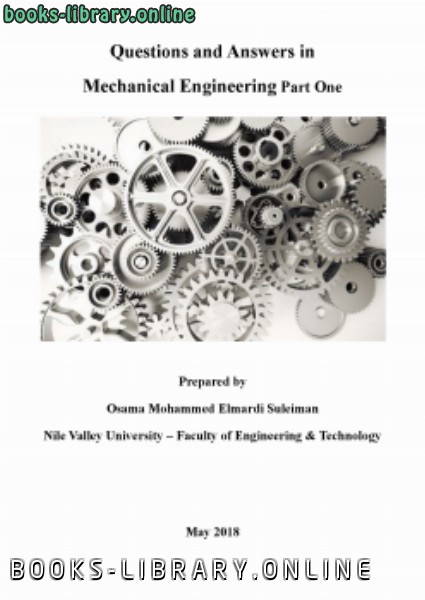[ملخصات] 📘 ❞ Questions and Answers in Mechanical Engineering Part One ❝ كتاب ــ أسامة محمد المرضي سليمان
الهندسة الميكانيكية - 📖 ملخصات كتاب ❞ Questions and Answers in Mechanical Engineering Part One ❝ ــ أسامة محمد المرضي سليمان 📖
█ _ أسامة محمد المرضي سليمان 0 حصريا كتاب ❞ Questions and Answers in Mechanical Engineering Part One ❝ 2024 One: One Prepared by Osama Mohammed Elmardi Suleiman Nile Valley University – Faculty of & Technology Question What are Properties Material which every Engineer Should Know? properties material: There mainly two types materials First one is metal other nonmetals Metals classified into types: Ferrous metals Non ferrous consist iron with comparatively small addition It includes its alloy such as cast iron, steel, HSS etc widely used mechanical industries for various advantages Nonferrous contain little or no aluminum, magnesium, copper, zinc Most associated these #1 Strength: The ability material to withstand load without failure known strength If a can bear more load, it means has Strength any depends on type loading deformation before fracture According types, be three 1 Tensile strength: 2 Compressive 3 Shear the fracture, Elastic Yield Ultimate #2 Homogeneity: 2 If same throughout geometry, homogeneous property homogeneity an ideal situation but practically #3 Isotropy: A elastic along all direction isotropic #4 Anisotropy: exhibits different #5 Elasticity: regains original dimension after removal virtue shape elasticity Every possesses some measure ratio stress strain under limit #6 Plasticity: undergo degree permanent plasticity This shaping working depending temperature #7 Ductility: Ductility drawn wires also define permits tensile amount (measure percentage elongation) decides either ductile not Percentage elongation = (Final Gauge Length Original Length) *100 greater than 5% gauge length 50 mm, if less الهندسة الميكانيكية مجاناً PDF اونلاين قسم خاص بكتب للتحميل مجال الميكانيكية" Mechanical engineering" والتي هي فرع هندسي يدرس الأنظمة الفيزيائية ويطبق أسس القوانين الفيزيائية الأساسية لتحليلها وإن أهم ما يميز علم الميكانيكا اعتماده على الرياضيات (بدلاً من التقدير) وعلى التجربة (بدلاً الملاحظة) حيث كيفية صياغة التنبؤات الكمية نظرياً وكيفية اختبار هذه الصياغات الرياضية بأدوات قياس مصممة بعناية و ايضا فرع هندسي يهتم بتصميم وتصنيع وتشغيل وتطوير الآلات أو الأجهزة المستخدمة مختلف قطاعات النشاطات الاقتصادية وبتعريف الموسوعة البريطانية فإن فروع تهتم بالتصميم والتطوير وبالتصنيع وبالتركيب المحركات والآلات وعمليات التصنيع وهي مهتمة بشكل بالقوى والحركة وهو علم بدراسة الطاقة بكافة صورها وتأثيرها الأجسام تخصص واسع له علاقة بكل مجالات الحياة فالهندسة تتعلق مثلا بصناعات الفضاء والطيران وبالإنتاج وتحويل وميكانيكا الأبنية والنقل وتكنولوجيا تكييف الهواء والتبريد وفي النمذجة والمحاكاة المعلوماتية A special section books field engineering, "Mechanical engineering", engineering branch that studies physical systems applies foundations basic laws analysis most important characteristic mechanics dependence mathematics (rather estimation) experience observation), where established how formulate quantum predictions theory, test mathematical formulas carefully designed measurement tools "Mechanical concerned design, manufacture, operation, development machines devices sectors economic activities By definition British Encyclopedia, development, installation, operation engines, machines, manufacturing processes particularly interested forces movement science studying energy forms effects objects broad discipline related areas life with, example, aerospace, aviation, production, transformation, building mechanics, transportation, air conditioning refrigeration technology, information modeling simulation


Questions and Answers in Mechanical Engineering Part One
Prepared by Osama Mohammed Elmardi Suleiman Nile Valley University – Faculty of Engineering & Technology
Question One What are Mechanical Properties of Material which every Mechanical Engineer Should Know? Mechanical properties of material: There are mainly two types of materials. First one is metal and other one is nonmetals. Metals are classified into two types: Ferrous metals and Non-ferrous metals. Ferrous metals mainly consist iron with comparatively small addition of other materials. It includes iron and its alloy such as cast iron, steel, HSS etc. Ferrous metals are widely used in mechanical industries for its various advantages. Nonferrous metals contain little or no iron. It includes aluminum, magnesium, copper, zinc etc. Most Mechanical Properties are associated with metals these are- #1. Strength: The ability of material to withstand load without failure is known as strength. If a material can bear more load, it means it has more strength. Strength of any material mainly depends on type of loading and deformation before fracture. According to loading types, strength can be classified into three types. 1. Tensile strength: 2. Compressive strength: 3. Shear strength: According to the deformation before fracture, strength can be classified into three types. 1. Elastic strength: 2. Yield strength: 3. Ultimate strength: #2. Homogeneity:
2
If a material has same properties throughout its geometry, known as homogeneous material and the property is known as homogeneity. It is an ideal situation but practically no material is homogeneous. #3. Isotropy: A material which has same elastic properties along its all loading direction known as isotropic material. #4. Anisotropy: A material which exhibits different elastic properties in different loading direction known as an-isotropic material. #5. Elasticity: If a material regains its original dimension after removal of load, it is known as elastic material and the property by virtue of which it regains its original shape is known as elasticity. Every material possesses some elasticity. It is measure as the ratio of stress to strain under elastic limit. #6. Plasticity: The ability of material to undergo some degree of permanent deformation without failure after removal of load is known as plasticity. This property is used for shaping material by metal working. It is mainly depending on temperature and elastic strength of material. #7. Ductility: Ductility is a property by virtue of which metal can be drawn into wires. It can also define as a property which permits permanent deformation before fracture under tensile loading. The amount of permanent deformation (measure in percentage elongation) decides either the material is ductile or not. Percentage elongation = (Final Gauge Length – Original Gauge Length) *100/ Original Gauge Length If the percentage elongation is greater than 5% in a gauge length 50 mm, the material is ductile and if it less than 5% it is not.
#276
0 مشاهدة هذا اليوم#83K
0 مشاهدة هذا الشهر#28K
9K إجمالي المشاهدات- 🎁 كن أول كاتب اقتباس في هذه الصفحة واحصل على هديّة 15 من النقاط فوراً 🎁
- ❞ كلام من ذهب
سر النجاح
نصائح:
قالت لى ستى:ستقابل يا بنى صعاب كثيرة فى هذه الحياة عليك التغلب عليها لكى تصل إلى مرادك ، فلا تعص الله وأمتثل لأوامره ولا تخالفه ولا تفعل شيئ يغضبه وتذكر دائما يا بنى أن الله هو الموفق ويجب أيضا عليك السعى والتعب ، لانك لا تشعر بلذة الفوز إلا حينما تتعب فلا تغرك الحياة يا بنى ولا يغرنك متاعها، لا تنسي يا بنى أن رضا الله هو فوز الدنيا والآخرة. ❝ ⏤هالة محمودكلام من ذهب
سر النجاحنصائح قالت لى ستى:ستقابل يا بنى صعاب كثيرة فى هذه الحياة عليك التغلب عليها لكى تصل إلى مرادك ، فلا تعص الله وأمتثل لأوامره ولا تخالفه ولا تفعل شيئ يغضبه وتذكر دائما يا بنى أن الله هو الموفق ويجب أيضا عليك السعى والتعب ، لانك لا تشعر بلذة الفوز إلا حينما تتعب فلا تغرك الحياة يا بنى ولا يغرنك متاعها، لا تنسي يا بنى أن رضا الله هو فوز الدنيا والآخرة
قراءة ملخص كتاب الحياة ⏤ هالة محمود





